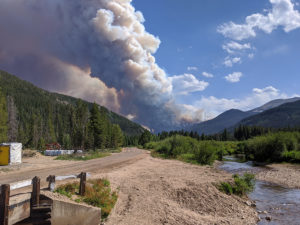
A federal agency awarded 12 Colorado State University researchers more than $3.1 million for such innovative science as improving how satellites show smoke plumes, using AI to predict precipitation, and, perhaps for the first time, evaluating how individual storms could change with climate intervention.
The three-year grants from the National Oceanic and Atmospheric Administration, or NOAA, are aimed at scientists studying climate science and community resilience.
Nearly all CSU recipients are based in the Department of Atmospheric Science, which is considered among the best graduate programs in the nation. All but one reside in the Walter Scott, Jr. College of Engineering; co-lead Thomas Borch, from the CSU College of Agricultural Sciences, has a dual appointment in the Department of Civil and Environmental Engineering.
Between 2016 and 2022, Colorado universities and organizations have attracted $29.1 million in NOAA funding. That is more than any other state, according to NOAA data.
Projects funded in 2022 that either have a CSU engineering faculty member as the lead investigator or a co-lead:

Structural fires at the wildland urban interface: Emission factors, inventories, and implications
Lead: Shantanu Jathar, Mechanical Engineering
Co-PIs: Christian L’Orange, Mechanical Engineering, Thomas Borch, Soil and Crop Sciences (Agricultural Sciences)
Goal: Study emissions from the combustion of common structural materials and their fuel complexes at different scales. Develop data and emissions inventory for structural fires specific to the wildland urban interface.
Award: $749,640
Improved retrievals of fresh and aged smoke properties from GOES satellite
Lead: Sonia Kreidenweis, Atmospheric Science
Co-PIs: Christine Chiu, Qijing (Emily) Bian, Atmospheric Science
Goal: Improve the characterization of smoke plumes from geostationary satellite observations, with a focus on providing insights into smoke spread, its temporal variability, and the impacts of transport and aging on smoke properties.
Award: $628,111
Explainable AI and process diagnostics to understand state-dependent precipitation forecast errors
Lead: Elizabeth Barnes, Atmospheric Science
Co-PI: Eric Maloney, Atmospheric Science
Goal: Use novel artificial intelligence to identify and improve forecasts from NOAA’s weather forecasting model of North American precipitation at subseasonal-to-seasonal lead times.
Award: $683,893
Assessing the impact of solar climate intervention on hazardous convective weather over the continental United States (CONUS)
Lead: Lantao Sun, Atmospheric Science
Co-PIs: Jim Hurrell and Kristen Rasmussen, Atmospheric Science
Goal: Use high resolution regional models to document how climate change is likely to affect severe storm systems, and the extent to which those changes might be mitigated by climate intervention.
Award: $719,000
Optimizing coupled boundary layer process studies in the tropical Pacific using high resolution models and in situ observations
Lead: Aneesh Subramanian, CU-Boulder
Co-PIs: Kris Karnauskas, CU-Boulder, Charlotte DeMott, CSU Atmospheric Science; Janet Sprintall, University of California San Diego
Goal: Identify and study key processes to determine the need for increased observations to help reduce systematic errors in modeling the coupled ocean-atmosphere boundary layer. DeMott’s role is to develop a climatology of western tropical Pacific Ocean conditions and low-level wind events associated with the onset of El Niño conditions.
Award: $889,912 ($111,734 to CSU)
Investigating the MJO-TC connection and its role in subseasonal US precipitation prediction
Lead: Daehyun Kim, University of Washington
Co-PIs: Eric Maloney, CSU Atmospheric Science, Suzana Camargo, Columbia University
Goal: Learn how problems in simulating east Pacific and Atlantic tropical cyclones, and their interactions with a weekly-varying tropical phenomenon called the Madden-Julian oscillation, lead to errors in simulating United States precipitation in NOAA’s weather forecasting model.
Award: $876,042 ($262,256 to CSU)
Dynamical downscaling to quantify extreme events under stratospheric Sulfate Aerosol Injection
Lead: Ben Kravitz, Indiana University
Co-PIs: Jim Hurrell, CSU Atmospheric Science
Goal: Use dynamical downscaling to simulate the impacts of climate intervention on extreme weather and climate events in the Midwest and the Western United States.
Award: $539,661 ($66,737 to CSU)